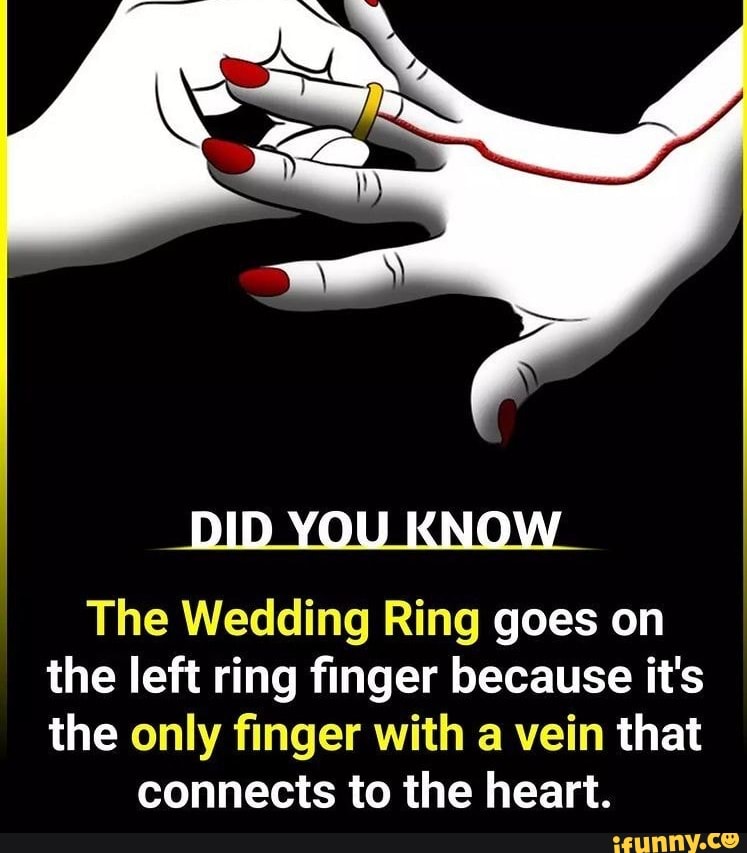
Claim: The wedding ring goes on the left ring finger because it’s the only finger with a vein that connects to the heart.
The illustration in the graphic depicts a gold ring placed next to the pinkie finger on the fourth finger of a right hand.
In the United Kingdom and other English-speaking nations, as well as Turkey, Italy, France, and Portugal, a wedding band is typically worn on the left hand. However, wedding bands are typically worn on the right hand in many nations.
We investigated further despite our earlier suspicions that this claim was false.
All fingers have veins that connect them to the heart. The cardiovascular system, which is made up of the heart, arteries, capillaries, and veins, moves blood around the body. The heart receives blood from the arteries and veins, respectively.
Every part of the body receives and sends blood through the cardiovascular system. Therefore, veins and arteries connect the entire body to the heart.
All of the fingers on both hands are affected by this. Anatomical models of the hand demonstrate that the veins in the fingers join to form larger veins that return to the heart. You have veins in all of your fingers, not just your left "ring finger."
According to Visible Body, a group that makes educational visualizations of the human body, the pattern of blood vessels in the hand "is pretty much all the same, and there isn't one vein in your hands linked directly to the heart."
Claim linked to vena amoris theory... Although this myth is untrue, some have traced this belief in a "love vein" back to the ancient Egyptians. The veins of the fingers join veins like the cephalic vein, which carries blood from the hand back to the heart. It was referred to as the vena amoris in Latin, but it is unclear whether this belief influenced the finger on which wedding rings are typically worn or why, in many countries of Western Europe, it was typically the fourth finger on the left hand.
British physician Charles Thompson cited 17th-century author Thomas Browne in a 1932 book on common folklore and superstitions, stating that the fourth finger "was chosen because a particular nerve, vein, or artery is conveyed thereto from the heart."
Mineralogist George Kunz quoted Roman philosopher Macrobius in 1917, whose most well-known work also mentioned the vena amoris.
However, there are other theories, Thompson wrote: Due to the left hand's inferiority to the right, the wedding ring was chosen for that hand, exemplifying obedience.
This means that a wife must obey her husband. In the United States, men began to wear wedding rings only in the 1940s and 1950s, and it is still uncommon in all countries.
Lillian Eichler, a US copywriter and author, wrote in 1924, "The ring is worn on the left hand to signify the subjection of the wife to the husband." The fact that this finger is the least used of all the fingers is probably the real reason why the ring is on it.
Other theories suggest that before putting the ring on the bride's fourth finger, either the priest or the groom would touch the bride's first three fingers with the ring and recite "In the name of the Father, of the Son, and of the Holy Ghost."
What ring finger is it?
To make matters even more difficult, there is a lack of agreement regarding which finger is the "ring" finger both historically and currently.
In his first-century Natural History, Pliny the Elder said that people used to wear rings on what is now called the ring finger. However, this changed when it became popular to wear rings on multiple fingers.
In France, wedding rings were worn on the right hand, sometimes on the middle finger, from the eleventh to the fifteenth centuries.
Kunz attributes the popularity of particularly large wedding rings to the fact that it was briefly fashionable in England to wear wedding rings on the thumb.
Conclusion: In addition to the fact that "the left ring finger" is not the only finger that has a vein connecting it to the heart, the finger on which you wear your wedding ring has always been determined by where and when you lived.

0 Comments